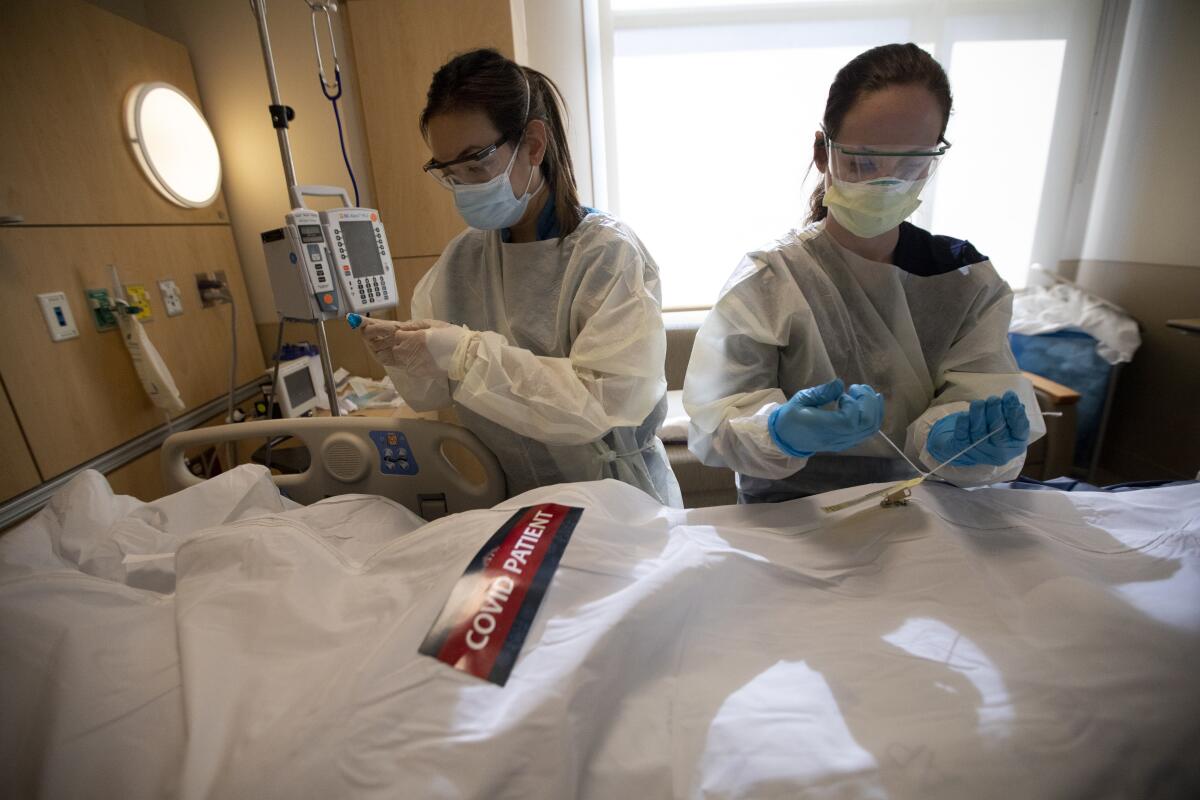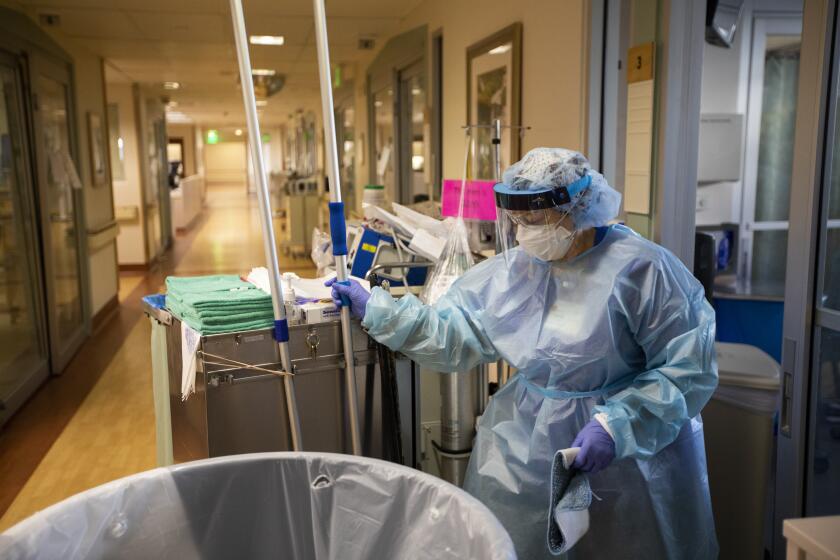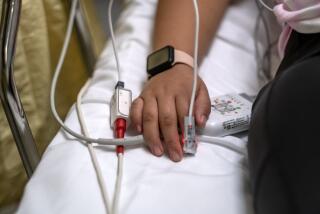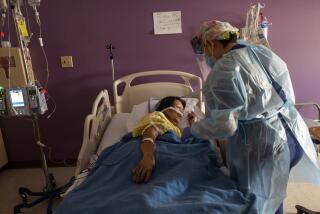Short on equipment, ambulances and oxygen, L.A. County hospitals face darkest month

- Share via
The coronavirus crisis battering Los Angeles County’s medical system is reaching increasingly desperate levels, with healthcare providers running low on equipment, ambulance operators being told not to bring patients who have virtually no chance of survival to hospitals, and officials scrambling to ensure they can provide enough lifesaving oxygen for critically ill patients.
The number of COVID-19 patients in the county’s beleaguered hospitals has hit an all-time high, according to data released Monday, and officials say they expect the situation to worsen in the coming weeks as a new surge of people who were infected during the holidays become ill.
With available resources being stretched thin, hospitals are trying to discharge patients as quickly as possible to free up space for those most in urgent need of care.
But there are limits to this strategy because the number of new cases continues to grow so rapidly. Around Christmas, more than 700 people with confirmed or suspected coronavirus infections were entering L.A. County hospitals every day, but only about 500 people were leaving — either through discharge or death — on a daily basis.
Already, officials report shortages of available ambulances, people in need of hospitalization being forced to wait in ambulances for as many as eight hours to get into emergency rooms, and grim calls by doctors and nurses about who gets treated first and who must wait for care.
“Many hospitals have reached a point of crisis and are having to make very tough decisions about patient care,” Dr. Christina Ghaly, the L.A. County director of health services, said Monday.
Across the county, doctors and nurses said they are dealing with once unimaginable conditions. At Harbor-UCLA Medical Center near Torrance, the ICU is running at 150% of its normal capacity.
Chief medical officer Dr. Anish Mahajan said the hospital is approaching the end of its supply of ventilators as well as dialysis machines to care for patients with kidney problems. Two refrigerated trucks are parked in back of the hospital because the morgue regularly runs out of space for more bodies.
“As hospitals go over capacity ... all supplies and equipment get stretched as well, in addition to the people,” he said. “We are basically overrun with critically ill patients.... It’s extraordinarily difficult. People are exhausted.”
The hospital is expecting more staffing help on Thursday, this time from the U.S. Department of Defense. Harbor-UCLA will receive six combat medics, three respiratory therapists and 11 nurses who will help treat the influx of patients at the hospital for at least the next 30 days. Additional staffing will go to L.A. County-USC Medical Center, the county’s flagship public hospital on the Eastside.
But because the COVID-19 surge is hitting so much of the country at once, officials have said before that they expect relatively few reinforcements — even as the number of patients keeps increasing.
The L.A. County Emergency Medical Services Agency issued a directive Monday that ambulance crews should conserve oxygen by administering it only to patients who have oxygen saturation levels below 90%. To reduce demand on hospitals, the agency recently issued memos directing ambulance staff not to transfer to hospitals most patients who have virtually no chance of survival.
In pre-pandemic times, those with slim odds of pulling through were taken to the hospital, as there was capacity to accommodate even the most unlikely recovery scenarios.
Patients who are not to be taken to hospitals include those whose hearts have stopped and, despite efforts at resuscitation, have no signs of breathing, movement, a pulse or blood pressure and would be declared dead at the scene. Paramedics and emergency medical technicians are to continue to try to resuscitate in the field until a pulse can be restored, after which a patient could be stabilized and taken to a hospital.
California registered more than 74,000 new coronavirus cases Monday — 11% higher than the previous record for a single day.
Emergency rooms are so overburdened that some patients are having to wait inside ambulances for as long as eight hours before entering the hospital. That backlog ties up ambulances and keeps them from being able to respond to other emergency calls.
To deal with the shortage, officials have devised an emergency plan to create temporary “ambulance-receiving spaces” — set up just outside the emergency room entrance and often covered by tents or canopies — to accept patients.
A paramedic or emergency medical technician may be used to assist with monitoring up to four patients in such areas, a change from the conventional practice of having the patient remain inside the ambulance until the emergency department is ready to let the patient in. Officials say the plan allows more ambulances to leave the hospital and return to circulation.
An ambulance-receiving space can be implemented only with permission from the L.A. County Emergency Medical Services Agency’s Medical Alert Center. The threshold is met when all available patient treatment areas in the emergency room — including hallways — are fully occupied and when at least three ambulances or at least three patients managed by EMTs or paramedics must wait for more than an hour.
The pandemic’s toll on healthcare systems throughout L.A. County and California as a whole was evidenced further Monday when Gov. Gavin Newsom unveiled an oxygen strategy to beef up the state’s reservoir of resources and provide assistance and other support to hard-hit areas that desperately need the vital therapeutic.
As part of that effort, California has created a state oxygen team, and the Army Corps of Engineers has sent specialized crews to update oxygen-delivery systems at a handful of L.A. County’s aging hospitals.
The state is also working to augment support for home oxygen usage so some patients can recover outside a hospital setting — allowing for “more availability and more capacity within our existing facilities,” Newsom said.
“We’re just looking at the panoply of oxygen support … across the spectrum and looking how we can utilize more flexibility and broader distribution of these oxygen units all up and down the state, but particularly in these areas — San Joaquin Valley and Los Angeles, the larger Southern California region — that are in particular need and are under particular stress,” he said.
Officials are also working on identifying and removing barriers to discharging patients to lower levels of care.
“For example, there are beds available in some skilled nursing facilities,” said Dr. Jeffrey Gunzenhauser, L.A. County’s chief medical officer, “and we are doing everything possible to remove restrictions so patients who are well enough to be discharged from hospitals can move to those skilled nursing facilities.”
Patients who could be moved might include those who have suffered a heart attack or stroke and don’t need to stay in the hospital but must receive intense nursing support, he said. Such arrangements make more sense than setting up a field hospital or medical ship, as was done earlier in the pandemic, because the medical infrastructure and staff are already in place, he said.
After a brief New Year’s Eve and New Year’s Day drop, hospitalizations for COVID-19 patients continued breaking records in L.A. County, rising to a new high of 7,898 on Sunday, the most recent data available, a net addition of 201 people from the previous day. Of those patients, 1,627 were in the ICU, also a record.
On Monday, an additional 79 COVID-19 deaths were reported in L.A. County and an additional 10,851 coronavirus cases. The county is now averaging 184 deaths a day over the past week — equal to a death every eight minutes — and about 13,500 cases a day, a count expected to grow since many testing sites were closed for the New Year’s holiday.
California tallied a record number of new coronavirus cases in a single day Monday — 74,135, breaking the high last set on Dec. 28, when 66,726 cases were recorded. The state also recorded its sixth-highest single-day tally of COVID-19 deaths — 379. Over the last week, California has been averaging 353 deaths a day, a record.
“We’re likely to experience the worst conditions in January that we’ve faced the entire pandemic, and that’s hard to imagine,” said L.A. County Public Health Director Barbara Ferrer said.
The growth in the number of COVID-19 patients in L.A. County’s ICUs has been astonishing — quadrupling since late November.
“Everyone should keep in mind that community transmission rates are so high that you run the risk of an exposure whenever you leave your home,” Ferrer said. “Assume that this deadly, invisible virus is everywhere, looking for a willing host.”
Hospitals were struggling to treat as many patients as they could while also keeping their employees and the public safe.
Orange-and-white plastic moveable barricades blocked the entrance to the emergency room of Huntington Memorial Hospital in Pasadena on Monday.
Masked guards patrolled the complex, some in golf carts and most with hand-held or clipped walkie-talkies, and directed confused visitors on where to go and how to proceed.
Those dropping off a loved one proceeded beyond the barricade, where prospective patients were met by waiting nurses in white gowns, surgical masks and face shields. Families and friends said their goodbyes there because visitor access is denied.
Times staff writers Hayley Smith, Colleen Shalby, Taryn Luna, Alex Wigglesworth, Andrea Roberson, Iris Lee and Sandhya Kambhampati contributed to this report.
More to Read
Sign up for Essential California
The most important California stories and recommendations in your inbox every morning.
You may occasionally receive promotional content from the Los Angeles Times.


















